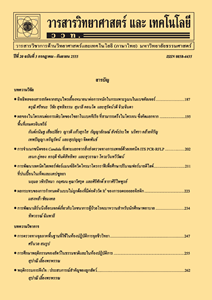การพัฒนาน้ำสลัดไขมันต่ำเสริมแป้งข้าวก่ำ
Main Article Content
Abstract
The objective of this research was to develop low fat salad dressing supplemented with purple rice flour. The central composite design (CCD) was used to study the effect of three independent variables including rice bran oil (10-30 %), purple rice flour (1.0-7.0 %), and xanthan gum (0.1-0.6 %) on rheological properties and color (L*, a*, b*) of salad dressing. The three formulas of salad showing the similar rheological properties to the commercial low-fat salad dressing were selected for sensory evaluation using 9-point hedonic scale. It was found that the ratio of rice bran oil: purple rice flour: xanthan gum equaled to 25.95 : 5.78 : 0.50 by weight gave the highest score of color and flavor but the sensory acceptance in consistency, taste and overall liking was not significant different (p ≥ 0.05). The flow behavior of salad dressing changed from shear thinning to Herschel-Bulkley after pasteurizing. The consistency coefficient and the yellowness value (b*) of salad dressing increased but the redness value (a*) decreased with storage time at 25 ºC for 28 days. The antioxidant activity (EC50) was not significantly changed along the storage time.
Article Details
References
[2] Drakos, A. and Kiosseoglou, V., 2008, Depletion flocculation effects in egg-based model salad dressing emulsions, Food Hydrocoll. 22: 218-224.
[3] Featherstone, S., 2016, Mayonnaise and Salad Dressing Products, a Complete Course in Canning and Related Processes, pp. 369-384, In Woodhead Publishing Series in Food Science, Technology and Nutrition, 14th Ed., Woodhead Publishing, Sawston.
[4] Hayati, I.N., Man, Y.B.C., Tan, C.P. and Aini, I.N., 2009, Droplet characterization and stability of soybean oil/palm kernel olein o/w emulsions with the presence of selected polysaccharides, Food Hydrocoll. 23: 233-243.
[5] Bortnowska, G., Balejko, J., Schube, V., Tokarczyk, G., Krzemińska, N. and Mojka, K., 2014, Stability and physicochemical properties of model salad dressings prepared with pregelatinized potato starch, Carbohydr. Polym. 111: 624-632.
[6] Wendin, K. and Hall, G., 2001, Influence of fat, thickener and emulsifier contents on salad dressing: Static and dynamic sensory and rheological analyses, Lebensm. Wiss. Technol. 34: 222-233.
[7] Chirstianson, D., Hodge, J.E., Ohborne, D. and Detroy, R.W., 1981, Gelatinization of wheat starch as modified by xanthan gum guar gum and cellulose gum, Cereal Chem. 58: 513-520.
[8] Somto, S., 2004, Physical and Chemical Characteristics and Stability of Thai Pigmented Rice, Master Thesis, Silpakorn University, Nakhon Pathom, 153 p.
[9] Leelawat, B., Phairot, S. and Samphanprida, S., 2017, Rheological properties of low-fat salad dressing thickened by rice flour-xanthan gum combinations, J. Sci. Technol. UBU 19(2): 98-107. (in Thai)
[10] Banjong, W., 2007, Development of Low Cholesterol Salad Dressing, Master Thesis, Kasetsart University, Bangkok, 132 p.
[11] Hsu, C.Y., Chan, Y.P. and Chang, J., 2007, Antioxidant activity of extract from Polygonum cuspidatum, Biol. Res. 40: 13-21.
[12] Imeson, A., 1997, Thickening and Gelling Agents for Food, 2nd Ed., Blackie Academic & Professional, London, 577 p.
[13] Manojai, G., Purple Rice: Important Nutritious Plant Species that is Worthy of Conservation, Available source: https://www.info.mation.co.th/techno/techno, October 10, 2010. (in Thai)
[14] Bahnassey, Y.A. and Breene, W.M., 1994, Rapid visco analyzer (RVA) pasting profiles of wheat, corn, waxy corn, tapioca and amaranth starch in the presence of konjac flour, gellen, guar, xanthan and locust bean gums, Starch/Stärke 46: 134-141.
[15] Wang, S., Li, C., Copeland, L., Niu, Q. and Wang, S., 2015, Starch retrogradation: A comprehensive review, Compr. Rev. Food Sci. Food Safety 14: 568-585.
[16] Fennema, O.R., 1996, Food Chemistry, 3rd Ed., Marcel Dekker, Inc., New York.
[17] Sui, X., Bary, S. and Zhou, W., 2016, Changes in the color, chemical stability and antioxidant capacity of thermally treated anthocyanin aqueous solution over storage, Food Chem. 192: 516-524.
[18] Kim, A.N., Kim, H.J., Chun, J., Heo, H.J., Kerr, W.L. and Choi, S.G., 2018, Degrada tion kinetics of phenolic content and antioxidant activity of hardy kiwifruit (Actinidia arguta) puree at different storage temperatures, Lebensm. Wiss. Technol. 89: 535-541.
[19] Vegara, S., Mena, P., Martí, N., Saura, D. and Valero, M., 2013, Approaches to understanding the contribution of anthocyanins to the antioxidant capacity of pasteurized pomegranate juices, Food Chem. 141: 1630-1636.


